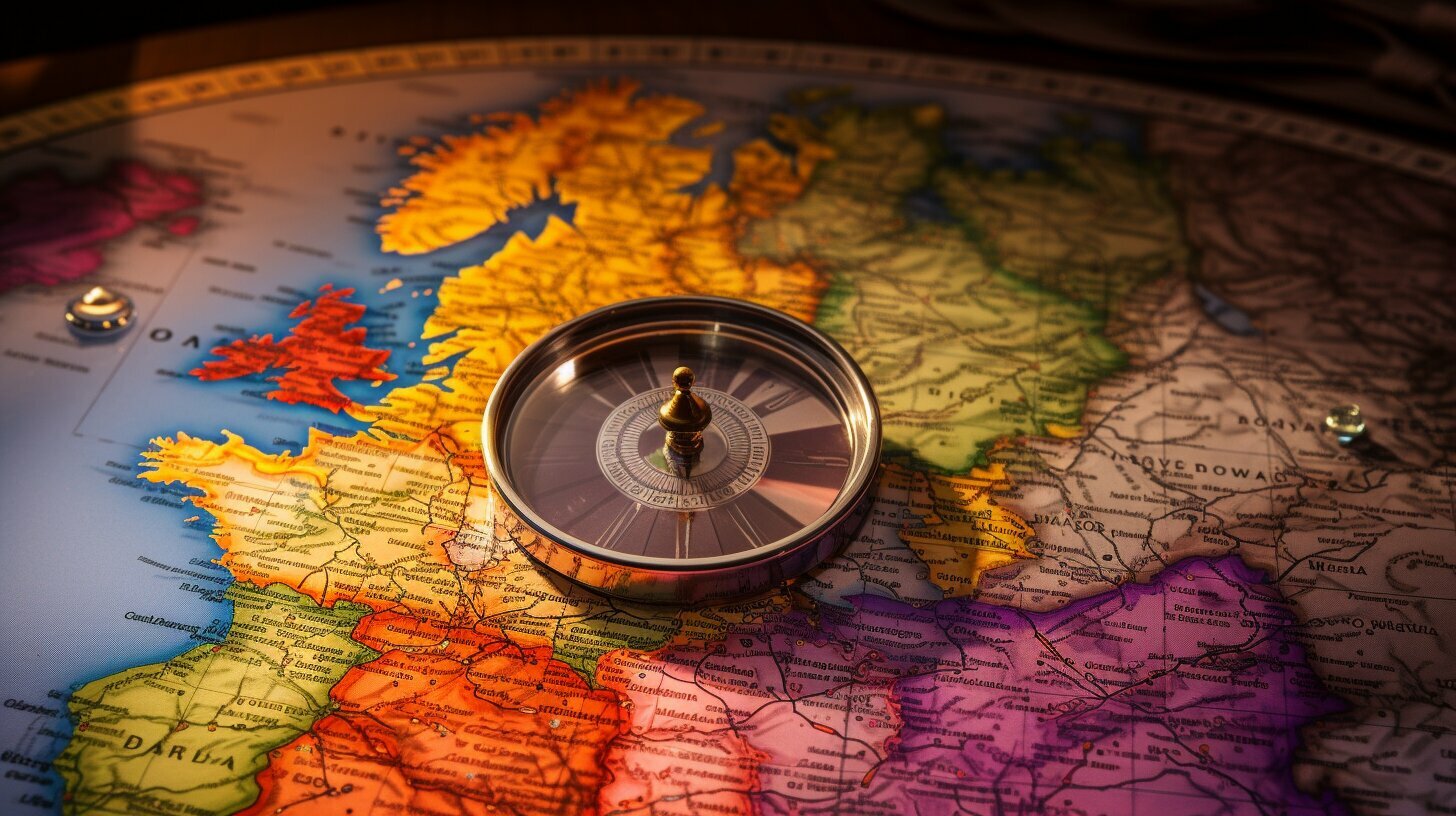England is a country that is part of the United Kingdom, located in Europe. It shares land borders with Wales to its west and Scotland to its north. To the east, it is separated from continental Europe by the North Sea, and to the south, by the English Channel. Covering approximately 62% of the island of Great Britain, England also includes over 100 smaller islands.
The area now known as England was first inhabited by modern humans during the Upper Paleolithic era. The country takes its name from the Angles, a Germanic tribe that settled there in the 5th and 6th centuries. England became a unified state in the 10th century and has since had a significant cultural and legal impact on the wider world.
England has been the origin of many well-known worldwide exports, including the English language, English law, association football, and the Church of England. Its capital and largest city is London. With a population of 56.3 million, England comprises approximately 84% of the total population of the United Kingdom, mostly concentrated around London and other major industrial regions.
The terrain in England consists of low hills and plains, with upland and mountainous areas found in the north and west of the country.
Key Takeaways:
- England is a country within the United Kingdom, located in Europe.
- It shares land borders with Wales and Scotland.
- The North Sea and the English Channel separate England from continental Europe.
- England covers approximately 62% of the island of Great Britain.
- It has had a significant cultural and legal impact on the wider world.
England’s Geographical Position
England is bordered by Wales to its west and Scotland to its north, and is separated from continental Europe by the North Sea to the east and the English Channel to the south. This prime location within the United Kingdom places England in a unique position both geographically and culturally.
The country covers approximately 62% of the island of Great Britain and includes over 100 smaller islands. Its diverse terrain consists of low hills and plains, with upland and mountainous areas found in the north and west. This varied landscape offers breathtaking natural beauty and is a draw for outdoor enthusiasts and nature lovers.
England’s coastal regions are also worth noting, as it boasts stunning coastlines along the North Sea and the English Channel. These coastal areas provide opportunities for seaside activities, such as sunbathing, swimming, and exploring picturesque seaside towns.
In addition to its geographical features, England’s location has historically played a pivotal role in its development. It has facilitated trade and cultural exchanges with neighboring countries, influencing its language, customs, and traditions. This has contributed to England’s rich heritage and its significant cultural and legal impact on the wider world.
| Key Points: |
|---|
| – England shares borders with Wales and Scotland |
| – It is separated from continental Europe by the North Sea and the English Channel |
| – The country covers 62% of Great Britain and includes over 100 smaller islands |
| – England’s terrain consists of low hills and plains, with upland and mountainous areas in the north and west |
England’s geographical position has shaped its history, culture, and identity. It remains a land of natural beauty, historical significance, and vibrant communities, making it a fascinating destination for locals and tourists alike.
Historical Background of England
The area now known as England was first inhabited by modern humans during the Upper Paleolithic and took its name from the Angles, a Germanic tribe that settled there in the 5th and 6th centuries. The region has a rich and diverse history, with influences from various cultures and civilizations. Here, we explore the historical background of England, tracing its origins and development over the centuries.
Throughout its history, England has been shaped by significant events and periods. From the Roman occupation in the 1st century AD to the Viking invasions in the 9th century, England experienced various waves of conquest and cultural assimilation. The Norman Conquest of England in 1066, led by William the Conqueror, brought about a new era of governance and introduced the feudal system.
During the medieval period, England saw the rise of the Plantagenet dynasty and the establishment of the Magna Carta in 1215, which laid the foundation for principles of individual rights and limitations on royal power. The Tudor era, marked by the reigns of Henry VIII and Elizabeth I, witnessed religious and political turmoil, as well as the expansion of England’s influence through exploration and colonization.
The Industrial Revolution and Modern England
The Industrial Revolution, which began in the late 18th century, transformed England into a global economic powerhouse. It brought about significant advancements in manufacturing, transportation, and technology, leading to urbanization and social changes. The 19th and 20th centuries witnessed further developments, including the expansion of the British Empire, two world wars, and the establishment of the welfare state.
Today, England continues to be a culturally rich and influential country. Its historical legacy is evident in its landmarks, traditions, and institutions. From the iconic Tower of London to the renowned universities of Oxford and Cambridge, England’s history is deeply woven into the fabric of its society. Its contributions to literature, science, and the arts have shaped the world we live in.
| Key Historical Periods | Notable Events |
|---|---|
| Prehistoric and Roman Britain | Celtic tribes, Roman conquest |
| Anglo-Saxon England | Germanic migrations, Viking invasions |
| Norman Conquest and Medieval England | Battle of Hastings, Magna Carta |
| Tudor and Stuart England | Henry VIII, Elizabeth I, English Reformation |
| Industrial Revolution | Advancements in manufacturing and technology |
In conclusion, England’s historical background is a fascinating tapestry of conquest, cultural exchange, and innovation. From its ancient origins to the transformative Industrial Revolution, England’s history has shaped its identity and left a lasting impact on the world.
Cultural and Legal Impact of England
England has had a significant cultural and legal impact on the wider world, being the origin of many well-known exports such as the English language, the English law system, association football, and the Church of England. These contributions have left an indelible mark on various aspects of society, shaping the way we communicate, govern, and even play sports.
The English language, with its rich vocabulary and widespread usage, has become a global lingua franca, connecting people from different countries and cultures. Its influence can be seen in literature, music, and film, where English has become the language of choice for international communication and expression.
| English Law System | Association Football | Church of England |
|---|---|---|
| The English legal system, known for its common law tradition, has served as a model for legal systems around the world. Its principles of justice, fairness, and the rule of law have been adopted in many countries, shaping their legal frameworks and institutions. | Association football, commonly known as soccer, originated in England and spread globally, becoming the most popular sport in the world. English football clubs, such as Manchester United and Liverpool, have gained worldwide recognition, attracting fans from all corners of the globe. | The Church of England, also known as the Anglican Church, has played a significant role in shaping religious practices and beliefs. As the mother church of the Anglican Communion, it has influenced the development of Protestantism and has a global following. |
Through these cultural and legal contributions, England has not only impacted the present, but also left a lasting legacy for future generations. Its language, legal system, sporting traditions, and religious practices continue to shape societies and influence our daily lives, both in the United Kingdom and beyond.
Major Cities and Population
England’s capital and largest city is London, and the population of England, which comprises 84% of the population of the United Kingdom, is mostly concentrated around London and other major industrial regions. With a population of approximately 9 million people, London is a dynamic and diverse metropolis that serves as the economic, cultural, and political hub of the country.
In addition to London, England is home to several other major cities that have played significant roles in the nation’s history and development. These include Manchester, Birmingham, Liverpool, Leeds, and Newcastle upon Tyne. Each of these cities has its own unique characteristics and contributions, whether it be in the field of commerce, industry, culture, or education.
Furthermore, England’s population is not evenly distributed across the country. The majority of people reside in the southern regions, particularly in the Southeast and Greater London areas. These areas have experienced rapid urbanization and economic growth, attracting people from all over the country and the world.
Table: Population of England’s Major Cities
| City | Population |
|---|---|
| London | 9,304,016 |
| Manchester | 547,627 |
| Birmingham | 1,153,717 |
| Liverpool | 491,500 |
| Leeds | 474,632 |
| Newcastle upon Tyne | 300,196 |
These major industrial regions not only contribute to England’s economic prosperity but also play a crucial role in shaping its cultural landscape. They are centers of innovation, creativity, and trade, attracting businesses and entrepreneurs from various industries. Additionally, these regions offer a wide range of employment opportunities, making them attractive for both domestic and international workers.
England’s Terrain and Landscape
England’s terrain consists mostly of low hills and plains, but it also includes upland and mountainous regions in the north and west. The country offers a diverse range of landscapes, making it a captivating destination for nature enthusiasts.
The low hills and plains are predominantly found in the south and east, forming the heartland of England. These areas are characterized by fertile agricultural land, picturesque countryside, and charming villages. The landscapes are adorned with rolling green hills, dotted with grazing livestock and vibrant wildflowers during the warmer months.
In contrast, the upland and mountainous regions in the north and west provide breathtaking views and opportunities for outdoor adventures. The North Pennines, Lake District, Yorkshire Dales, and Peak District are just a few examples of the stunning upland areas that await exploration. These regions boast rugged terrains, towering peaks, sparkling lakes, and cascading waterfalls, creating a dramatic and awe-inspiring backdrop.
England’s diverse topography allows for a variety of outdoor activities and recreational pursuits. Hiking enthusiasts can embark on challenging trails that lead to panoramic viewpoints, while cyclists can enjoy scenic routes through picturesque countryside. The upland areas also offer fantastic opportunities for rock climbing, mountaineering, and even winter sports during the colder months.
FAQ
Q: What country is England in?
A: England is a country that is part of the United Kingdom.
Q: Where is England located?
A: England is located in Europe and shares land borders with Wales to its west and Scotland to its north. It is separated from continental Europe by the North Sea to the east and the English Channel to the south.
Q: Who settled in England in the 5th and 6th centuries?
A: The Angles, a Germanic tribe, settled in England in the 5th and 6th centuries. The name “England” is derived from their name.
Q: What cultural and legal impact has England had on the world?
A: England has had a significant cultural and legal impact on the wider world. It is the origin of many well-known exports, including the English language, the English law system, association football, and the Church of England.
Q: What is the capital city of England?
A: The capital and largest city of England is London.
Q: What is the population of England?
A: England’s population is approximately 56.3 million, which comprises 84% of the population of the United Kingdom. The population is largely concentrated around London and other major industrial regions.
Q: What is the terrain of England like?
A: England’s terrain consists of low hills and plains, with upland and mountainous terrain in the north and west.



